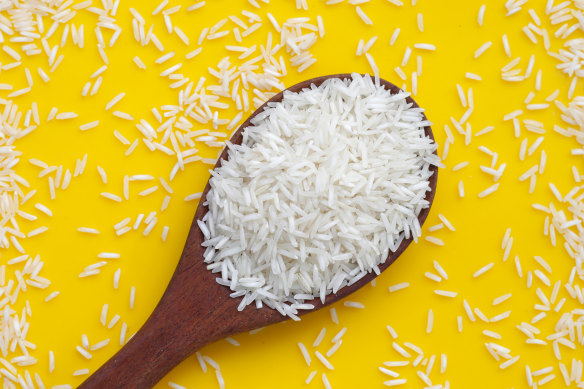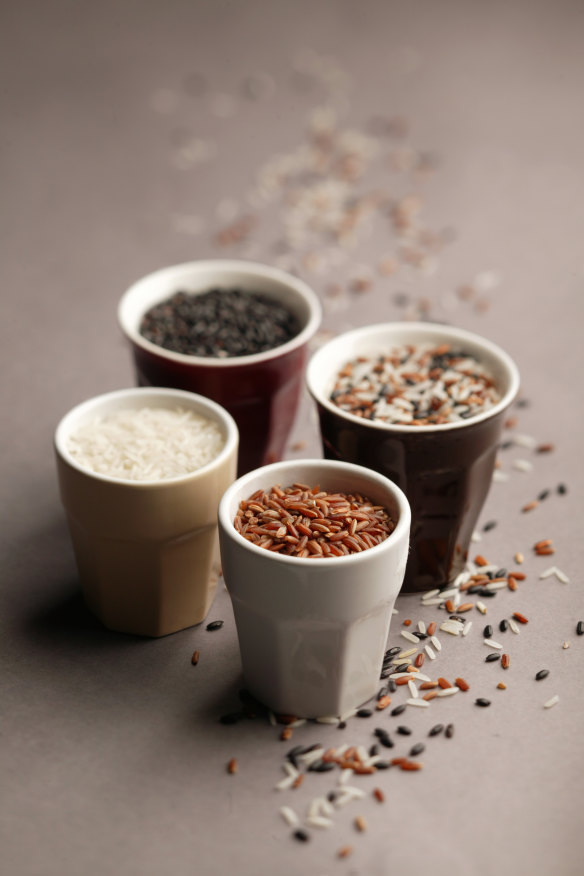The five healthiest types of rice – and the one to cut back on
From a nutritional perspective, not all rices are created equal. Here’s how the different types stack up.
With the fake meats market now worth $US8.5 billion it’s scientists, not farmers, who are growing the foods of the future. Indeed, a team from Yonsei University in South Korea have just created a protein-enriched “meaty” rice, where the grains are infused with lab-grown beef muscle and fat cells, which they claim offers a more eco-friendly source of protein.
Meat-infused rice doesn’t sound particularly appetising, but could this pink-hued “frankenfood” catch on? The developers claim it contains 8 per cent more protein than regular rice and has a much smaller carbon footprint than beef. Sounds impressive, but bearing in mind that 100g of cooked white rice contains 2.7g of protein, even beefed up by 8 per cent this is still only 2.9g, a trifling amount compared to the 25g of protein contained in the same weight of cooked beef.
And should we be eating more rice anyway, protein-enriched or otherwise? Regular white rice is comprised primarily of refined carbohydrates, which can spike blood sugar levels, something we are told to avoid if we want to prevent type 2 diabetes in later life. But not all rice is created equal, and wholegrain, fibre-rich varieties can form part of a healthy, balanced diet. Here’s how the different types of rice stack up.

White rice
100g cooked weight contains: 130 calories, 0.4g fibre, 2.7g protein, GI (glycaemic index) 70
If you’re keeping an eye on your weight and blood sugar, you might want to give this grain a wide berth. White rice is the most refined variety, meaning the fibre-rich bran layer and the nutritious germ (or seed embryo) have been removed. What remains is the endosperm, comprised of starchy carbohydrates, which means white rice has a higher GI (or glycaemic index, the speed at which foods raise blood sugar levels, measured on a scale of 1-100*) than less refined varieties. Short-grain white rice has the highest GI of 70+, while long-grain versions, such as basmati and jasmine, are lower at about 60.
Tip: Pair white rice with protein (meat, fish, eggs, tofu) and fibre (vegetables) which will lower the overall glycaemic load of the meal.
Brown rice
100g cooked weight contains: 123 calories, 1.6g fibre, 2.7g protein, GI (glycaemic index) 50
Brown rice is a whole grain, which means it retains the bran layer and the germ, so the fibre content is higher (fibre has several important roles including aiding digestion and preventing constipation). It also contains more minerals, such as manganese, selenium and magnesium, than white rice. While brown rice is still high in carbohydrates, the mitigating effect of the fibre lowers the GI to around 50, and as such it is classed as a low-GI food.
Tip: Brown rice can taste a little “cardboardy” so a nutritious compromise is to mix it 50/50 with white rice. Cook the brown rice for 30 mins, adding the white rice halfway through.

Black rice
100g cooked weight contains: 142 calories, 1.4g fibre, 3.3g protein, GI (glycaemic index) 35
Black rice has the lowest GI of all the rice varieties at 35, and is stuffed with antioxidant anthocyanins, the plant compounds that account for its deep colour. Antioxidants protect our cells from damage, also called oxidative stress, which has been linked to many chronic conditions, such as heart disease, certain cancers and cognitive decline.
Tip: Use black rice as the dramatic base for a salad, mixed with avocado, sliced radishes and spring onions. Dress with olive oil, honey, lime juice and a few red chilli flakes.
Red rice
100g cooked weight contains: 189 calories, 2.9g fibre, 4.6g protein, GI (glycaemic index) 55
Although red rice has a slightly higher GI than black rice it also boasts an impressive array of antioxidants including apigenin, myricetin and quercetin, the latter being a powerful anti-inflammatory which studies have shown can help reduce the symptoms of inflammatory conditions such as rheumatoid arthritis. Red rice is also impressively high in protein and fibre.
Tip: With its robust texture, red rice is a great choice for an oven-baked rice dish along with chicken, spices and vegetables.
Wild rice
100g cooked weight contains: 101 calories, 2.0g fibre, 4.0g protein, GI (glycaemic index) 45
Wild rice is not technically rice at all but a species of aquatic grass from North America called Zizania. As such it has a slightly different, chewier texture and is lower in calories than its Asian counterpart. It is also a “complete” protein, meaning it contains all nine essential amino acids the body needs, whereas “true” rice lacks the amino acid lysine so it is best combined with other plant foods, such as beans, to ensure protein needs are met on a vegan or vegetarian diet.
Tip: Wild rice works particularly well in soup. Try adding a pouch of pre-cooked wild rice to your favourite chicken soup.
Quinoa
100g cooked weight contains: 149 calories, 2.8g fibre, 4.8g protein, GI (glycaemic index) 53
OK it’s not rice but it is an excellent wholegrain alternative that, like wild rice, is a complete protein and contains more protein overall than regular rice – a real boon for those following a plant-based diet.
Tip: Quinoa has a natural bitter coating called saponin so remember to rinse thoroughly before cooking.
*High GI foods have a score of between 70-100, medium GI foods 56-69 and low GI foods 55 or less
The Telegraph, London
The best recipes from Australia's leading chefs straight to your inbox.
Sign up